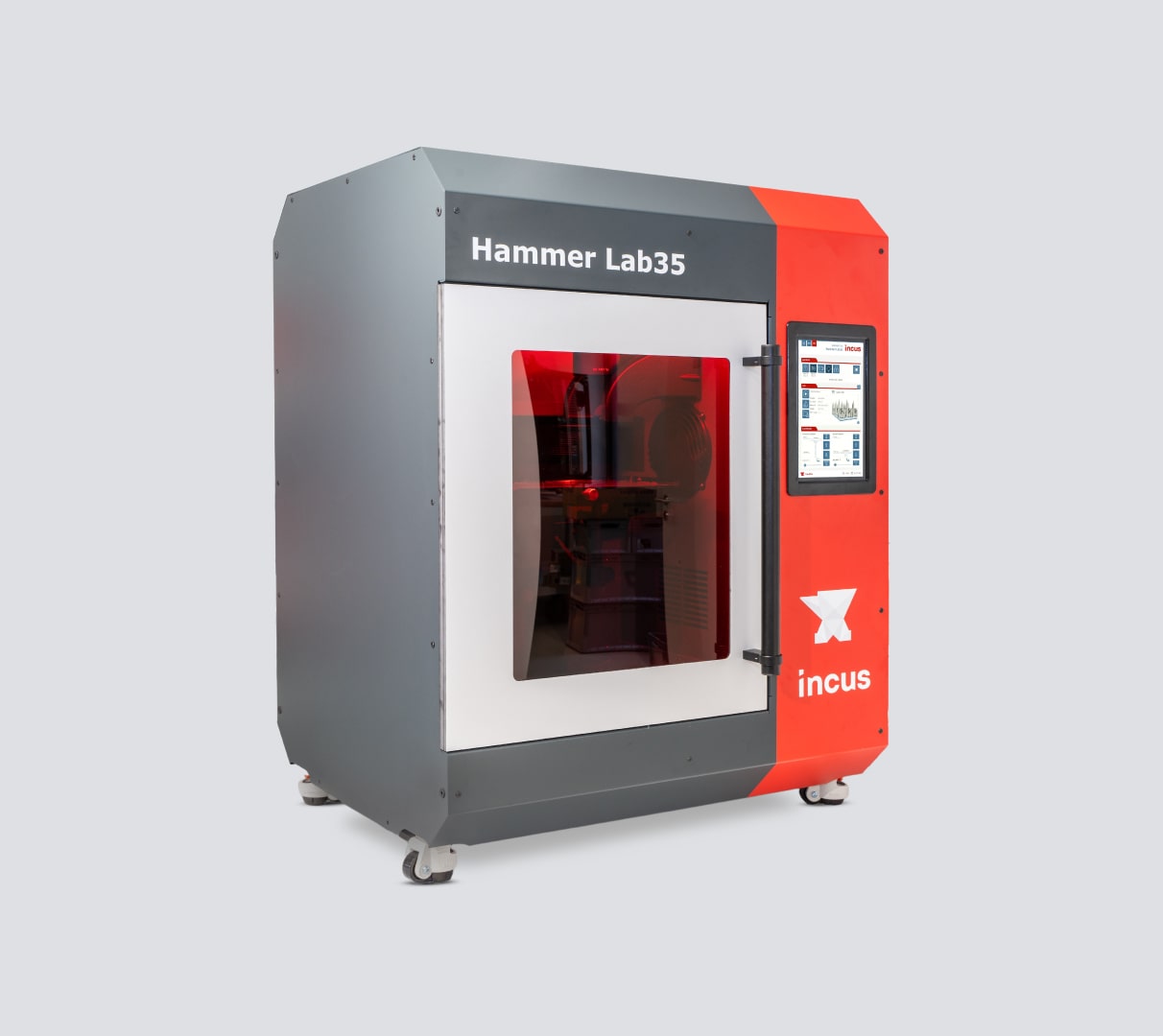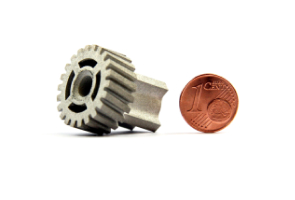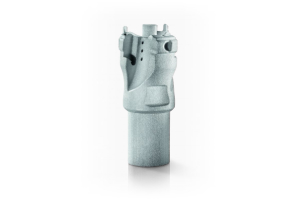Device
LMM 3D printer: Hammer Lab35
The LMM (Lithography-based Metal Manufacturing) process is characterized by shaping through photopolymerization of a mixture of photosensitive resin and metal powder. Due to the light, lamination is extremely stable and can realize high-precision and small components.

Machine Parameters for Hammer Lab35
Made by
Incus GmbH
Lateral resolution
35 / 15 μm (customised)
Number of pixels (X, Y)
2560 x 1600
Building Volume (X, Y, Z)
89.6 x 56 x 120 mm
Slice thickness
10 - 100 μm
Building chamber
Full climate control
Building velocity
Up to 250 slices/h
Print speed
Up to 100 cm3/h
3D printing process
In the LMM method of 3D printing, the following process is used for modeling.
First, CAM data is created from 3D CAD data, and the 3D printer is used for modeling. After that, the workpiece is melted except for the hardened part by photo-polymerization, and then a workpiece made of metallic powder and photosensitive resin is obtained. At this stage, the metal powder is still unstable because the density of the metal powder is not high and there is an extra material called resin (this state is also called a green body).
The obtained workpiece is "dewaxed and sintered" in the next process. At this stage, the resin material is melted and volatilized (degreased), and the remaining metal powders are agglomerated and sintered. In the LMM method (and the binder jet method), this sintering process is an important process that determines the quality of the final part, and knowledge and know-how related to sintering are important. Through a carefully controlled dewaxing and sintering process, the density of the final metal part is increased to 98% or more, and the surface is finished to a level that allows mirror-finishing.
In summary, the LMM method uses light to form a green body from a mixture of photosensitive resin and metal powder through photo-polymerization, and after dewaxing and sintering, produces the same metal modeling as the MIM method. The advantage of this method is that the material and sintering technologies of μ-MIM® can be deployed directly, which is useful for verification. Since light is used, stacking is extremely stable and part accuracy of ±0.2% or less is possible. In addition, since the workpiece can be removed after molding without applying force, it is possible to mold delicate and complex shapes. As a result, quality comparable to μ-MIM® can be achieved.
First, CAM data is created from 3D CAD data, and the 3D printer is used for modeling. After that, the workpiece is melted except for the hardened part by photo-polymerization, and then a workpiece made of metallic powder and photosensitive resin is obtained. At this stage, the metal powder is still unstable because the density of the metal powder is not high and there is an extra material called resin (this state is also called a green body).
The obtained workpiece is "dewaxed and sintered" in the next process. At this stage, the resin material is melted and volatilized (degreased), and the remaining metal powders are agglomerated and sintered. In the LMM method (and the binder jet method), this sintering process is an important process that determines the quality of the final part, and knowledge and know-how related to sintering are important. Through a carefully controlled dewaxing and sintering process, the density of the final metal part is increased to 98% or more, and the surface is finished to a level that allows mirror-finishing.
In summary, the LMM method uses light to form a green body from a mixture of photosensitive resin and metal powder through photo-polymerization, and after dewaxing and sintering, produces the same metal modeling as the MIM method. The advantage of this method is that the material and sintering technologies of μ-MIM® can be deployed directly, which is useful for verification. Since light is used, stacking is extremely stable and part accuracy of ±0.2% or less is possible. In addition, since the workpiece can be removed after molding without applying force, it is possible to mold delicate and complex shapes. As a result, quality comparable to μ-MIM® can be achieved.

Advantages of LMM
Print complex-shaped components
It is possible to print microscopic and complex shaped parts with a quality close to that of μ-MIM®.
Use the same equipment and technology
The same equipment and technologies used in μ-MIM® technology can also be used in this process.
Achieve very high precision for components
Tolerances of less than 0.2% are possible with this method.
Collaboration between 3D Printing and μ-MIM®
One of the barriers to the use of μ-MIM® in the past was the lead time and cost during prototyping and small lot production. Now, with the addition of metal 3D printing equivalent to μ-MIM® as an option for our customers, we can support you right from the prototype and small lot production stage - not only with MIM technology, but also as a partner for micro and complex shaped metal components.


Take a look at some components manufactured with 3D printing
Material
Size
Gear

Stainless Steel
φ15mm
Nozzle

Titanium Alloy
φ10×30mm
Schedule a free initial consultation with one of our experts
We will gladly answer your open questions and show you how we can help you solve your technical challenges.
